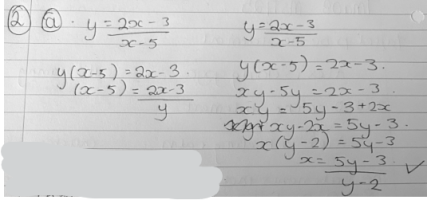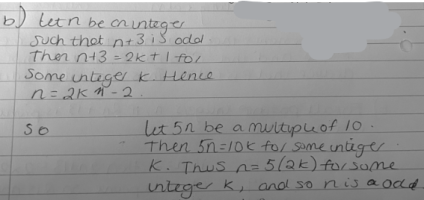HATLEY1997
Junior Member
- Joined
- Oct 24, 2023
- Messages
- 59




I’ve had another look at this today, am I right in thinking I need to add 3 to both sides to prove it is odd? Any other guidance would be helpfulFirst problem:
View attachment 38357
View attachment 38356
You need to use some words; say what you are proving in each part, and what is assumed, and why each step is valid. You might start like this: "Suppose that x and y are real numbers such that ...".
The first column appears to be abandoned; why is it there? And aren't you assuming that y is not zero, when you divide by it?
The second column is more useful; but you seem to be proving in only one direction, not "if and only if".
I myself would show that each equation is equivalent to the same equation, and then explain how that proves the goal. But they probably expect something that looks more like what you are trying to do.
Second problem:
View attachment 38358
View attachment 38359
Again, the first paragraph seems to be unused. Why did you do that part? What does it imply about n?
Also, although the second paragraph starts well, you make a huge leap in claiming you've shown n is odd. What does what you say have to do with the definition of oddness? (And is that really what you want to show? Does it even make sense?)
You may have some good ideas, but they aren't stated.
I'll leave the third problem for others.
Add 3 to both sides of what? Please show what you are suggesting you should do. That is, try doing it, and see if it helps!I’ve had another look at this today, am I right in thinking I need to add 3 to both sides to prove it is odd? Any other guidance would be helpful

Start with what is assumed in this part of the proof: that 5n is a multiple of 10 (not that n is a multiple of 10). How can you write that in terms of the existence of some integer k?Would I start with ?
n=10k
n+3=10k+3
Or n=10k
5n=50k
Or neither of these?
5n=10kStart with what is assumed in this part of the proof: that 5n is a multiple of 10 (not that n is a multiple of 10). How can you write that in terms of the existence of some integer k?
Now just show that 2k+3 must be odd. You are only one step away. (How is "odd" defined?)5n=10k
n=2k
n+3=2k+3
?
It can be written in form 2k+1, for some integer k. So am I only looking at the right side of the equation here?Now just show that 2k+3 must be odd. You are only one step away. (How is "odd" defined?)
Is it n+3= (2k+1)+2 ?C
It can be written in form 2k+1, for some integer k. So am I only looking at the right side of the equation here?
No, that doesn't do what you want.Is it n+3= (2k+1)+2 ?
You want to show that n+3 is odd, right? That is, that n+3 can be written in the form 2(?) + 1.It can be written in form 2k+1, for some integer k.
You've shown that n+3 can be written as 2k+3, and you want to show that n+3 can be written as 2(?)+1. So, yes, you want to rewrite 2k+3 as 2(...)+1.So should 2(?)+1 be equal to 2k+3?
Can you tell us what you are learning? (What is Unit 9 about? What course is it part of?)Sorry for all the messages. I don’t know why I am getting myself so confused with this. I really appreciate your help
